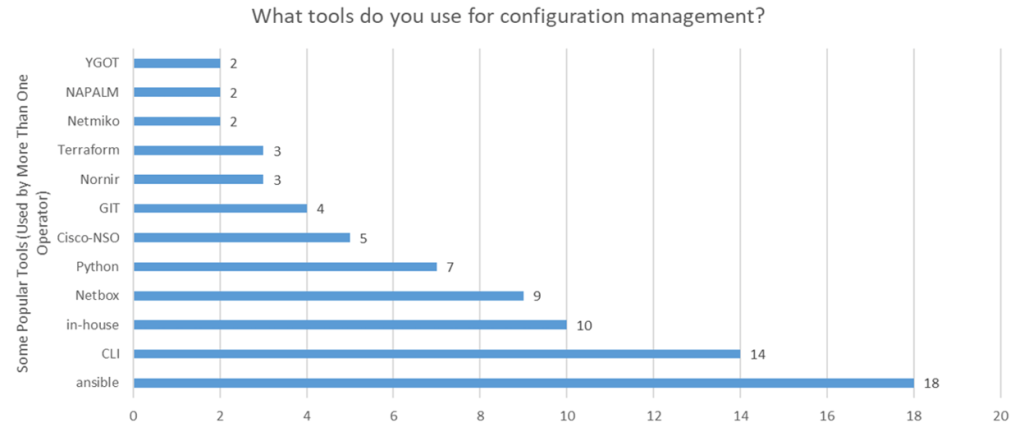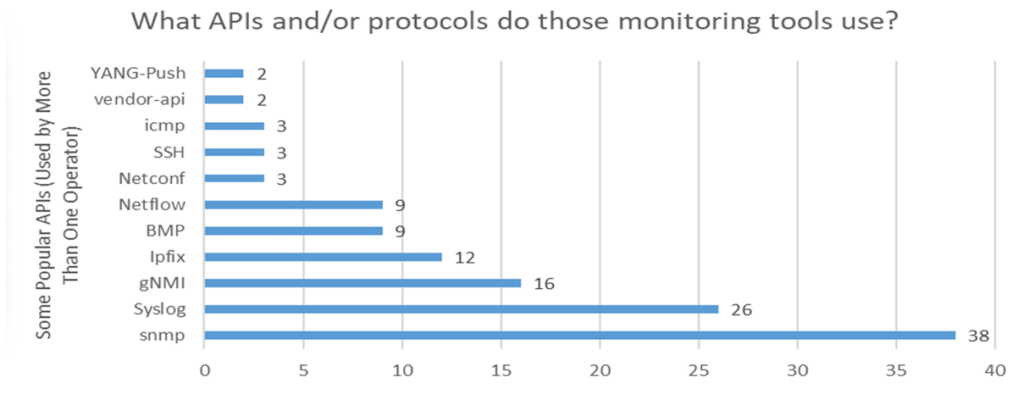
I recently attended NANOG 93 in Atlanta in the first week of February. The dominant theme of the presentations was the integration of network command and control automation with the use of Artificial Intelligence (AI) tools for managing these functions.
The interest in AI appears to have heightened of late, and while the hype levels are impressive even for an industry that can get totally fixated on hype, the deliverables so far still appear to fall somewhat short. I suspect we haven’t yet reached the peak of exaggerated claims about AI’s limitless applications in this field. The higher the level of hype, the higher the expectations for deliverables being placed on these efforts. The baseline functionality expected from AI in today’s networks continues to rise daily.
Understandably, this is a source of tension between suppliers (vendors) and customers as to the extent of customer-driven customization of the network equipment. Vendors prefer a limited set of configuration options to minimize the risk of customers misconfiguring the equipment, which could lead to unstable or damaging operational states.
At the same time, there is a strong push for it in the industry, all the way to customer-programmed routers. We have seen elements of this in switches with P4 and Intel’s Tofino switch ASIC offerings, and programmable interface drivers in general-purpose compute platforms, so it’s no surprise to see the same pressures emerge in the routing space between standalone packaged routing functionality and elastic platforms that require significant levels of added software to function.
There is also still tension in the networking space as to ‘whose network is it anyway?’ in terms of command-and-control functions that are intended to govern the behaviour of the network and the means of sharing the common resource across several concurrent network applications. The best illustration I can provide is the original CSMA/CD Ethernet as one extreme end of this model. The common cable had no command-and-control capability as it was just a passive component. The sharing of the network across the competing demands was a matter for each connected device and the application. The other extreme was the old carrier virtual circuit system where two endpoints of the network were interconnected by a synchronous virtual circuit implemented as a set of stateful rules in a sequence of carrier switches installed essentially by hand.
We’ve seen various networking technologies swing back and forth between fully stateless systems that exhibit a degree of self-regulation (and hence have reduced reliance on centralized command and control) and systems that recreate end-to-end virtual circuits by the imposition of network state through command and control. Network operators and vendors are eager to preserve the value of the network platform by integrating more functions into it — such as Quality of Service (QoS) and VPNs. However, the growing functionality in end systems and the increasing use of encryption to obscure end-application behaviour present a strong opposing force, effectively reducing the network’s role to that of a simple, undifferentiated commodity.
In this space, AI is being recruited by both parties. The network-centric view sees AI as a means of increasing the capability, accuracy, and scale function of command-and-control-driven network platforms, working closely with the automation of these functions. At the same time, AI functionality is being loaded into the application space in a myriad of ways. Some see this as a means of increasing the capability of end systems in the networked world in the same manner as a conventional traffic network: Passive roads and human drivers evolving to place the AI function into driving functions, rather than into a more nebulous concept of AI roads!
Network automation
The opening presentation for the meeting, by Kentik’s Justin Ryburn, was on the topic of network automation and AI. I’m reminded of the observations about self-driving cars — that it’s harder than it might’ve looked at the start! However, the theme of this presentation was the assertion that the technology platform for automation of a network’s command and control system is not the hardest part. The more challenging part is culture change both with a workforce that has built their career around mastering human interfaces to the network control systems and the vendors who build to what customers claim they want to buy. So, in 2025 we persist in using Command Line Interfaces (CLIs) to network equipment that has a continuous heritage to the command line interface of a PDP-11 minicomputer running RSX-11 in the 1970s! Change is hard.
I also think that part of this problem lies in an incremental approach to network automation. The resistance to change from the workforce is an issue when automation continues to work alongside human-controlled network command and control. I have yet to hear of a case study where the transition to a fully automated network was via a single ‘flag day’ where automation was installed comprehensively to replace every human-controlled network operational function. I’m not even sure any network operator would behave in such a seemingly reckless manner today! I guess that behind all the hype about how network automation is ready to roll out today, lies a large-scale lingering doubt about the true capabilities of such systems, and a consequent reluctance to pull all human operators out of the network control room. I can’t see this changing anytime soon.
gRPC
This shift toward network automation is associated with a shift in the model of interaction between an automated controller and the network elements it is intended to manage. Much of the network management still runs the venerable SNMP protocol, which, as the word ‘simple’ suggests, is a naive polling protocol. Nokia has developed a network management framework based on generalized Remote Procedure Calls (gRPC).
To me, this approach makes a whole lot of sense in the context of network management. It quickly leads to the adoption of a common object model by both the controllers and the objects being managed in this way. This allows the typical tasks of configuration management, troubleshooting and streaming telemetry applications to be implemented within a single RPC framework. They have also implemented a set of operational tools, including ping, traceroute, file get and put. There are also a set of services relating to authentication and credentials, and another set of services relating to forwarding and route management.

The gRPC framework is developed on top of Protobuf, rather than JSON. Protobuf is faster and allows a more compact representation of serialized data. It also uses the gRPC framework, implemented on top of an HTTP 2.0 transport. The latter aspect surprises me, as this is a serial transport base that can encounter head-of-line blocking. I had thought that QUIC would’ve been a more appropriate choice for transport here, as QUIC allows for multiple RPC threads that operate asynchronously — that is without inter-thread dependences and no head-of-line blocking.
IAB Workshop
A general view of the state of the industry for network management tools and techniques was provided in a report from the December 2024 IAB workshop on the Next Era of Network Management Operations. The survey report presented at this workshop provides an interesting snapshot of how networks are actually operated today.
A lot of effort has been put into various automation tools to manage networks, including NAPALM, Terraform, Ansible, and of course the persistent use of CLIs. The heartening news appears to be that the use of Ansible now exceeds that of using the device CLI, but these two tools are the two most popular configuration management tools being used in today’s networks (Figure 2).

SNMP is still a very widely used platform for these tools, as well as Netconf. For network monitoring, SNMP remains a firm favourite, while YANG-Push and Netconf have yet to gain a large base of adopters in this space (Figure 3).

It has often been observed in the transition to an IPv6 network that the plethora of dual-stack transition approaches that were developed by the IETF at the time served more to confuse that market than to facilitate a rapid and efficient transition. Similarly, the plethora of approaches to automation of network management has managed to fragment and confuse the space, and CLI and SNMP remain popular because of their simplicity, ease of use, and uniform availability. It’s not clear that this situation is going to be changing anytime soon.
Networking for AI
AI is not just a currently fashionable approach to the role of network operations. The computing characteristics to train the Large Language Models (LLMs) are intense and the trend in the compute cost (until the recent announcement of DeepSeek) has been up and to the right. Today’s models require hundreds, heading to thousands of GPUs to train these LLMs (Table 1).
| Model Name | Model size (billion parameters) | Dataset size (billion tokens) | Training ZETA FLOPS (10^21) | Number of GPUs |
| OPT | 175 | 300 | 430 | 474 |
| LLaMA | 65 | 1,400 | 600 | 662 |
| LLaMA 2 | 34 | 2,000 | 400 | 441 |
| LLAMA 3 | 70 | 2,000 | 800 | 882 |
| GPT-3 | 175 | 300 | 420 | 463 |
| GPT-4 (est) | 1,500 | 2,600 | 31,200 | 34,392 |
In AI data centres there is a need for a ‘backend’ switching fabric interconnecting connecting the servers that contain the GPUs. In many ways, this environment is operating in a manner more closely aligned to remote memory access, as distinct from remote procedure calls.
As with the evolution of the processing environment to achieve higher throughput some decades ago, the techniques of parallelism, pipelining, and segmentation can be used in the data centre to improve overall performance.
In very general terms, a local AI network is a large set of GPUs and a set of memory banks, and the network is cast into the role of a distributed common bus to interconnect GPUs to memory in a similar vein that the backplane of the old mainframe computer design was used to connect processing engines to a set of storage banks. Here Remote Memory Access (RMA) performance is critical, and the approach, in very general terms, is to enable the network to pass packet payloads directly to the hardware modules that write to memory and similarly assemble packets to send by reading directly from memory. The current way to achieve this is by Remote Direct Memory Access (RDMA) over Converged Ethernet (RoCE).
Network-intensive applications like AI, networked storage or cluster computing need a network infrastructure with high bandwidth and low latency. The advantages of RoCE over other network application programming interfaces such as the socket abstraction are lower latency, lower processing overheads and higher bandwidth. The idea of using the network for RMA — where data can be transferred between devices’ memory without involving their operating systems — is not new. RMA has existed for around 25 years and is commonly used in parallel computing clusters. However, these approaches had their shortcomings, including the lack of explicit support for multi-pathing within the network (which constrained the network service to strict in-order delivery), poor recovery from single packet failure and unwieldy congestion control mechanisms.
Ultra Ethernet is not a new media layer for Ethernet but is intended to be an evolution of the RMA protocol for larger and more demanding network clusters. The key changes are the support for multi-pathing in the network and an associated relaxing of the strict in-order packet delivery requirement. It also uses rapid loss recovery and improved congestion control. In short, it appears to apply the behaviours of today’s high-performance multi-path transport-level protocols to the RMA world. The idea is to use a protocol that can make effective use of the mesh topology used in high-performance data centre networks to allow the scaling of the interconnection of GPUs with storage, computation and distribution networks.
A critical part of this approach lies in multi-path support, which is based on dropping the requirement for strict in-order packet delivery. Each packet is tagged with its ultimate memory address, allowing arriving packets to be placed directly into memory without any order-based blocking. However, this does place a higher burden on loss detection within the overall RMA architecture.
Ultra Ethernet replaces silent packet discard with a form of signalled discard, like the Explicit Congestion Notification (ECN) signalling mechanisms used in L4S in TCP. If a packet cannot be queued in a switch because the queue is fully occupied, the packet is trimmed to a 64-octet header snippet and this snippet is placed into a high-priority send queue. Reception of such a trimmed packet causes the receiver to explicitly request retransmission from the sender for the missing packet, which is analogous to selective acknowledgment (SACK) signalling used in TCP.
The framework also proposes the use of fast startup, including adding data payloads to the initial handshake used to establish a flow. This approach eliminates the delay of a round-trip handshake before transmitting, as the connection is established on-demand by the first data packet.
The challenge for many networking protocols is to be sufficiently generic to be useful in a broad diversity of environments. If the protocol’s performance is evaluated within a more narrowly defined scenario, additional optimizations can be introduced to enhance its efficiency. This is precisely the case with Ultra Ethernet, which builds on the general concept of RMA over IP but makes specific assumptions about the environment and payload characteristics tailored to high-performance data centres used for data-intensive processing, such as AI applications. It’s an interesting approach to scaling in data centres, as it does not attempt to alter the underlying Ethernet behaviours, but pulls in much of the experience gained from high-performance TCP and applies it directly to an Ethernet packet RMA management library.
NANOG 93
The agenda, presentation material and recordings of sessions can all be found at the NANOG 93 website.
The views expressed by the authors of this blog are their own and do not necessarily reflect the views of APNIC. Please note a Code of Conduct applies to this blog.
